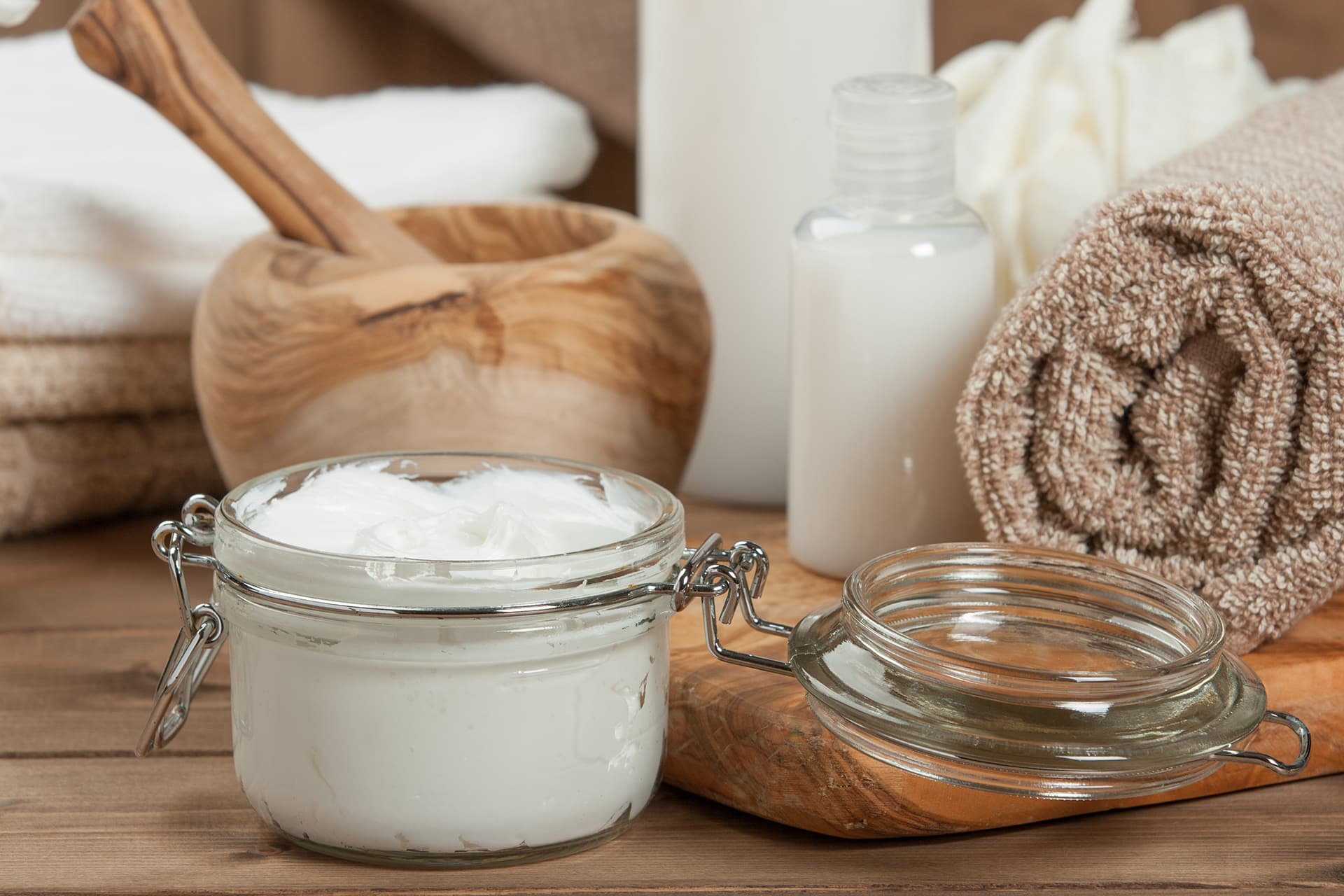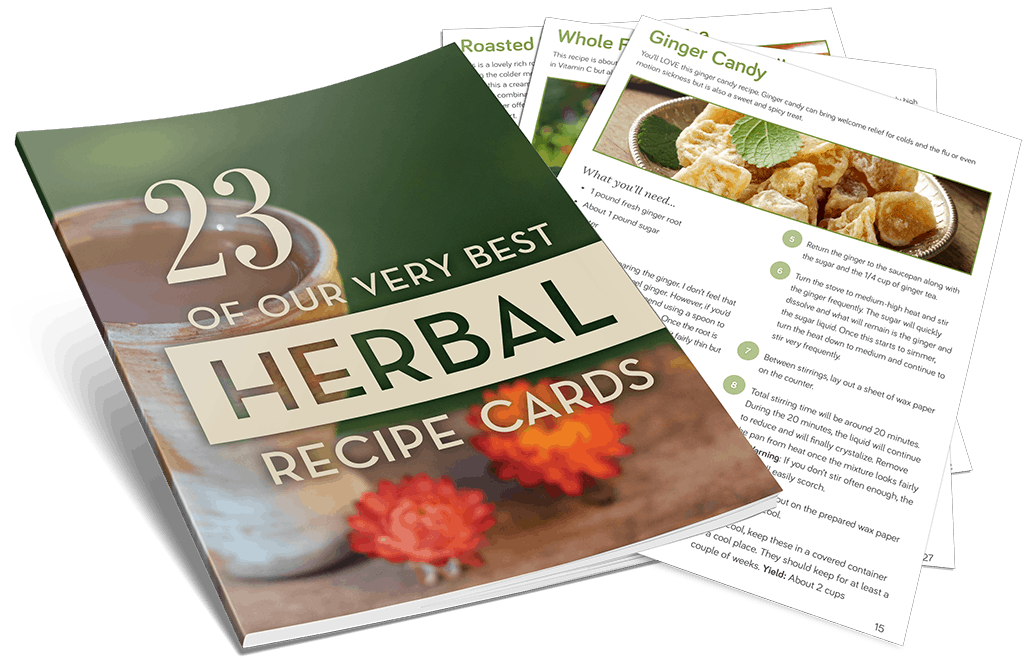Making an herbal lotion at home is a wonderful way to nourish dry skin and add more herbal goodness to your daily skincare routine. The first time I ever made an herbal lotion I was blown away: I had never experienced such a luxurious natural product for my skin. Ever since then, I’ve been totally hooked, and I keep a jar of herbal lotion stocked in my herbal apothecary at all times — plus, I also love giving homemade lotion to loved ones as a gift. In this post I’ll show you how to make lotion with healing herbs in your own kitchen, and I’ll answer some frequently asked questions about how to make lotion the easy way.

Prioritizing Your Daily Skincare Routine
Up until a few years ago I didn’t think much about skincare. Sure, I’d wash my face and apply a serum or two, but I wasn’t inspired to learn more or put more effort into this routine — I viewed skincare as somewhat frivolous and unimportant.
My relationship to skincare completely shifted when the pandemic hit. Faced with the intense overwhelm of pandemic times, I took stock of my daily mundane rituals and figured out ways to imbue them with more meaning and intention. After revamping my morning and nighttime routine, I turned to my skincare routine and asked myself, how can I bring more care and attention to this daily routine? And how can I make this a grounding self care ritual rather than a mindless obligation?
I began to study and experiment with making serums, lotions, creams, cleansers, toners, and exfoliants. As I nerded out about these topical remedies, I got more and more excited about my skincare routine: it became something to look forward to in my day that was about so much more than just skin. My skincare ritual became an opportunity to slow down, breathe deeply, and connect with my body regardless of how stressful the day is.
I’ve carried this skincare ritual with me over the last several years, and it has been a sweet anchor for me no matter how overwhelming the day is. So as I dive into the ins and outs of how to make lotion below, I invite you to not only get excited about making lotion but to also ask yourself how you can create a daily skincare ritual full of nourishing self care.
What is an Herbal Lotion?
First of all, let’s talk about lotion. Lotion is made through an emulsification of oil in water. Lotion’s high water content makes it very moisturizing and light on the skin, rarely leaving an oily residue like a salve or cream may. Since it’s less oily than salves and creams, lotion can work well for dry skin, oily skin, and sensitive skin types.
Making an herbal lotion simply means adding herbs to your ingredients. In this lotion, I’ve opted to use herbal-infused oils with cottonwood, rose, and calendula, as well as hydrosols, and aloe gel.

How to Make Lotion with Natural Ingredients
This natural lotion formulation is Kimberly’s Love Your Body Lotion, and it is a wonderful daily moisturizer for dry and oily skin alike. Below you can watch a step-by-step video of her making this lotion if you want a little more guidance. And if you need a little help making an infused oil for this lotion recipe, you can learn here.
Ingredients you’ll need…
- ¾ ounces beeswax
- 1/3 cup coconut oil
- 1/4 cup Balm of Gilead almond oil (cottonwood bud-infused oil)
- ¼ cup rose-infused almond oil
- ¼ cup calendula-infused grapeseed oil
- ⅓ cup chamomile hydrosol
- ⅓ cup rose hydrosol
- ⅓ cup aloe gel
- Melt the beeswax in the top of a double boiler. Remover from heat immediately.
- Add the coconut oil and stir until melted. Then add the infused grapeseed oil and almond oil and stir until they all are just liquefied.
- Pour the mixture into a blender and allow it to cool while you combine the remaining ingredients in a heat-resistant glass measuring cup with a pour spout.
- Now it’s time to combine the oil and water. Allow the oil to cool to just above room temperature.
- Turn the blender on, and bring it up to speed. Pour in the liquids while the blender is spinning.
- As soon as the blender “chokes,” turn it off. Use a spatula to gently stir any remaining water into the oils.
- Blend again on low for about 1 minute to smooth out the mixture for a fully finished emulsion.
- Once you’ve created a stable emulsion, pour the mixture into sterilized lotion-storage glass jars. This lotion should keep for about a year in sealed jars at room temperature — if over time you notice any signs of mold growth or a changing odor, color, or texture, then discard your lotion.
Yield: a few cups of lotion.
Lotion Can Be Hard to Make: Here’s a Video to Help
Since lotion requires emulsifying oil and water, this can be a tricky skincare product to make at home. That’s why Kimberly filmed a step-by-step video on how to make lotion at home. In this video, Kimberly shares how to make her Love Your Body Lotion.
And let’s be honest, lotion isn’t the only herbal recipe that could use a step-by-step video on how to make it. Whether you’re making a syrup, chapstick, or the perfect cup of tea, having easy-to-follow video guidance can be a game changer when it comes to feeling like a confident home herbalist.
That’s why LearningHerbs created Apothecary, a beautiful video collection that takes you step-by-step through some of the most popular and effective herbal remedies. Apothecary is the easiest way to learn herbal medicine making, and it guides you through building your home apothecary from the comfort of your own kitchen. Learn more and check out Apothecary here.
The Benefits of Cottonwood
Cottonwood lends its luxurious scent to this lotion, along with many healing gifts. Cottonwood is anti-inflammatory, antimicrobial, and can ease pain and tension.
The Benefits of Rose
Rose-infused oil and hydrosol gently address inflammation, while rose’s uplifting scent gladdens the heart. Rose-scented lotion is such a treat!

The Benefits of Chamomile
Chamomile is one of my favorite ingredients to work with when crafting skincare products. Like rose, it is also gentle and anti-inflammatory. Its subtle, calming scent promotes relaxation, which makes it a wonderful herb to include in any daily skincare routine.
The Benefits of Calendula
Calendula has many beneficial properties: widely known as the herb for skincare, calendula flowers can reduce inflammation and excess dryness. Calendula is especially indicated for any dry, red, itchy skin issues.
The Benefits of Aloe Gel
Beyond alleviating sunburns, aloe gel can sooth and alleviate myriad dry skin conditions. With its “antiaging” effects, aloe gel can smooth and soften the skin.

Here are some frequently asked questions about how to make a lotion with herbal ingredients…
How Do I Preserve My Lotion?
Making a lotion requires an emulsification of oil in water. When water is introduced into oil, this creates the possibility of microbial growth. The hydrosol and cottonwood in this lotion help prevent microbial growth. You can also sterilize all of your equipment prior to making your lotion in order to preserve your lotion longer. Refrigeration can also help preserve your lotion.
Since this lotion has no other preservatives in it, it important to check your lotion frequently for any signs of mold growth or a changing odor, color, or texture — if you notice any of these changes, then discard your lotion.
If you would like to create a longer lasting lotion that includes more preservatives, check out this calendula lotion recipe here. In this article, herbalist Sade Musa shares all about vitamin E, grapefruit seed extract, and Liquid Germall Plus — including whether vitamin E and grapefruit seed extract even work! Sade’s recipe also includes other popular lotion ingredients like shea butter, cetyl alcohol, and emulsifying wax.
And if you’d like to create skincare products that will last longer without needing more preservatives, you could create oil-based skincare products like herbal salves, body butters, and lotion bars. All of these products will have a heavier, more oily finish, so they are especially indicated for tougher areas of the body like dry hands.

What Makes a Good Lotion?
A good homemade herbal lotion is made with love and lots of healing herbs. One of the best ways to make a super luxurious lotion is to make sure the infused oils you use in your lotion are strong. You can learn how to make a high quality infused oil here. Another key to making a good lotion is patience: sometimes creating an emulsion can be tricky, so it’s important to be patient with yourself throughout the process. Watching Kimberly’s step-by-step guide to making lotion above is an invaluable resource for creating a stable emulsification at home.
What Type of Water Should I Use in My Lotion?
In this recipe, we’re using hydrosols as the water ingredients of the lotion. Hydrosols are aromatic waters made through the process of distilling plant matter, and they contain low concentrations of essential oils.
You could also used distilled water instead of a hydrosols in your homemade lotion.
Where Can I Get Ingredients to Make Lotion?
To make this herbal lotion you should be able to find the basic ingredients, including the herbs, oils, and essential oil at your local herb or health food store. The hydrosols may be more challenging to find in person, and you can easily order them online from Mountain Rose Herbs.









I am allergic to anything to do with bees. what can I use in place of honey and bees wax?
Hi Jana, thank you for your question. One of the most common plant-based waxes that people use instead of beeswax for topical products is candelilla wax. I have not used candellila wax for this lotion recipe, so when working with this wax you may have to play around a bit with the proportions of wax, oil, and water to reach your desired lotion consistency. I hope you enjoy the lotion recipe! :)
This recipe looks wonderful! Thanks for sharing it.
I am curious what this lovely lotion smells like? I would love to make mine have a light rose scent, (just like my grandma’s lotion used to smell….i think it was called Rose Milk).
Hi Rebecca, what a great idea! This lotion has a strong cottonwood scent. If you’d like to bring in more of a rose scent, you could use entirely rose hydrosol (instead of both chamomile and rose) and add rose geranium essential oil to the recipe. You could add 5 drops of essential oil per 1 oz of oil used in the lotion recipe
Hi Jana
Wonderful recipe and love the video! Two questions, what is the best way to clean the blender after making the lotion? and second, have you ever tried using an immersion blender? I can see the downside is that you might need assistance in pouring the waters into the oils at the same time you are blending, but I have found cleaning the immersion blender is super simple.
Hi Dianne, thank you for your questions! After I’ve scooped out as much lotion as I can from my blender, I then wipe down the blender with a rag or paper towel. After this I wash the blender with dish soap and warm water. And yes, you can totally use an immersion blender — that’s actually what I tend to use when making lotions/creams. Just keep in mind that emulsification can sometimes take a little longer / be a little more challenging to achieve with an immersion blender. Enjoy! :)
Hi! Thank you for this beautiful recipe. Any tips on how to help your herbal lotion if it comes out too runny?
Hi Erin, thank you for asking! Yes, if an herbal lotion comes out too runny there can be a few things happening. You may need to need to play around with the ratio of ingredients and add more beeswax and oil to the recipe. Or, if you live in a hot climate, refrigerating your lotion can help it maintain a thicker consistency. Hope this helps! :)